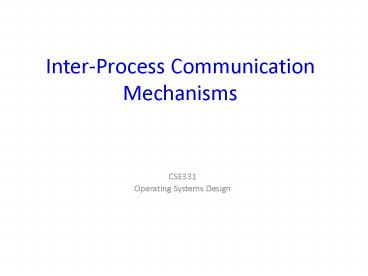INTERPROCESS COMMUNICATION - PowerPoint PPT Presentation
Title:
INTERPROCESS COMMUNICATION
Description:
BY:- PRIYANKAR TIWARI BRIJPRAKASH PAL ADARSH TIWARI ABHISHEK SINGH – PowerPoint PPT presentation
Number of Views:41
Title: INTERPROCESS COMMUNICATION
1
Inter-Process Communication Mechanisms
- CSE331
- Operating Systems Design
2
Cooperating Processes
- Independent process cannot affect or be affected
by the execution of another process. - Cooperating process can affect or be affected by
the execution of another process - Advantages of process cooperation
- Information sharing
- Computation speed-up
- Modularity
- Convenience
- Dangers of process cooperation
- Data corruption, deadlocks, increased complexity
- Requires processes to synchronize their processing
3
Purposes for IPC
- Data Transfer
- Sharing Data
- Event notification
- Resource Sharing and Synchronization
- Process Control
4
IPC Mechanisms
- Mechanisms used for communication and
synchronization - Message Passing
- message passing interfaces, mailboxes and message
queues - sockets, STREAMS, pipes
- Shared Memory Non-message passing systems
- Common examples of IPC
- Synchronization using primitives such as
semaphores to higher level mechanisms such as
monitors. Implemented using either shared memory
or message passing. - Debugging
- Event Notification - UNIX signals
5
Message Passing
- In a Message passing system there are no shared
variables. IPC facility provides two operations
for fixed or variable sized message - send(message)
- receive(message)
- If processes P and Q wish to communicate, they
need to - establish a communication link
- exchange messages via send and receive
- Implementation of communication link
- physical (e.g., shared memory, hardware bus)
- logical (e.g., syntax and semantics, abstractions)
6
Implementation Questions
- How are links established?
- Can a link be associated with more than two
processes? - How are links made known to processes?
- How many links can there be between every
pair/group of communicating processes? - What is the capacity of a link?
- Is the size of a message that the link can
accommodate fixed or variable? - Is a link unidirectional or bi-directional?
7
Message Passing Systems
- Exchange messages over a communication link
- Methods for implementing the communication link
and primitives (send/receive) - Direct or Indirect communications (Naming)
- Symmetric or Asymmetric communications
- Automatic or Explicit buffering
- Send-by-copy or send-by-reference
- fixed or variable sized messages
8
Direct Communication Internet and Sockets
- Processes must name each other explicitly
- Symmetric Addressing
- send (P, message) send to process P
- receive(Q, message) receive from Q
- Asymmetric Addressing
- send (P, message) send to process P
- receive(id, message) rx from any system sets
id sender - Primitives
- send(A, message) send a message to mailbox A
- receive(A, message) receive a message from
mailbox A - Properties of communication link
- Links established automatically between pairs
- processes must know each others ID
- Exactly one link per pair of communicating
processes - Disadvantage a process must know the name or ID
of the process(es) it wishes to communicate with
9
Indirect Communication - Pipes
- Messages are sent to or received from mailboxes
(also referred to as ports). - Each mailbox has a unique id.
- Processes can communicate only if they share a
mailbox. - Properties of communication link
- Link established only if processes share a common
mailbox - A link may be associated with more than 2
processes. - Each pair of processes may share several
communication links. - Ownership
- process owns (i.e. mailbox is implemented in user
space) only the owner may receive messages
through this mailbox. Other processes may only
send. When process terminates any owned
mailboxes are destroyed. - system owns then mechanisms provided to create,
delete, send and receive through mailboxes.
Process that creates mailbox owns it (and so may
receive through it) but may transfer ownership to
another process.
10
Indirect Communication
- Mailbox sharing
- P1, P2, and P3 share mailbox A.
- P1, sends P2 and P3 receive.
- Who gets the message?
- Solutions
- Allow a link to be associated with at most two
processes. - Allow only one process at a time to execute a
receive operation. - Allow the system to select arbitrarily the
receiver. Sender is notified who the receiver
was
11
Synchronizing Message Flow
- Message passing may be either blocking or
non-blocking. - blocking send sender blocked until message
received by mailbox or process - nonblocking send sender resumes operation
immediately after sending - blocking receive receiver blocks until a message
is available - nonblocking receive receiver returns immediately
with either a valid or null message.
12
UNIX Pipes
- Pipe sets up communication channel between two
(related) processes.
Two processes connected by a pipe
37
13
- One process writes to the pipe, the other reads
from the pipe. - Looks exactly the same as reading from/to a file.
- System call
- int fd2
- pipe(fd0)
- fd0 now holds descriptor to read from pipe
- fd1 now holds descriptor to write into pipe
14
Shared Memory
- Common chunk of read/write memory
- among processes
Proc. 2
Proc. 1
15
Command-line IPC control
- ipcs
- Lists all IPC objects owned by the user
- ipcrm
- Removes specific IPC object































